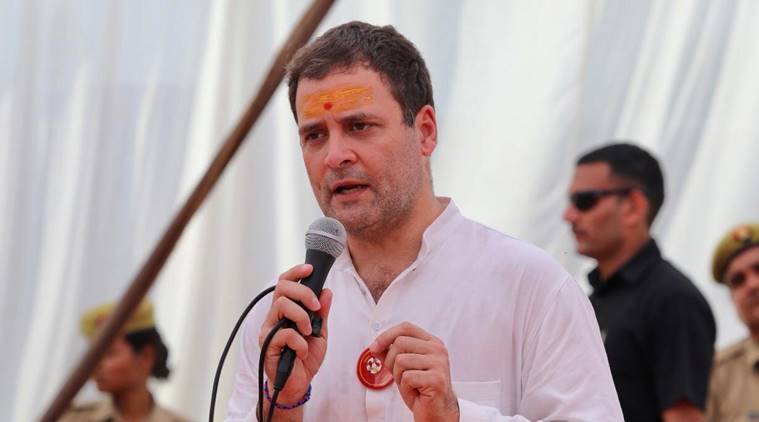 Congress president Rahul Gandhi
Congress president Rahul Gandhi
The editorial in Panchjanya targets Congress president Rahul Gandhi for his continuous attack on the Narendra Modi-led NDA government over the Rafale aircraft deal. The editorial calls Rahul “over excited” on the issue, and says his aggressiveness has created panic for other Congress leaders. The editorial claims that there was no room left to play politics after Air Force Deputy Chief Air Marshal R Nambiar asserted that the recent Rafale aircraft deal was “much better” than the one negotiated earlier.
The editorial adds: “First, the facts on the same issue, the Rafale deal, cannot differ across platforms. Rahul initially gave a figure of Rs 36,000 crore but,after four tweets, the figure has reached Rs 1,300,00 crore”. It also claims that Rahul took an alleged remark of former French President Francois Hollande on the Rafale deal as a confirmation of his allegations of a scam. But the Congress president has forgotten that people in France have stopped taking Hollande seriously. Another thing Rahul forgot, according to Panchjanya, is that the replacement of Hindustan Aeronautics Limited (HAL) with Reliance was made a part of the deal when Manmohan Singh was prime minister and Sonia Gandhi was the Congress president.
Two Swarajists
The editorial in Organiser draws parallels between Pandit Deendayal Upadhyaya and Mahatma Gandhi. After the celebration of the 102nd birth anniversary of Upadhyaya, the 150th birth anniversary of Gandhi has begun this week. “While discussing these two stalwarts and their contribution, we tend to take a partisan view, without understanding the philosophical foundation of their thinking and the contemporary relevance of the same. If we carefully analyse the fundamental thought processes of both, though in different times, the unanimity of purpose and principles is striking,” the editorial claims. It adds that Gandhi, in Hind Swaraj, tries to explain the true meaning of “swaraj” and explores the root causes of colonialism. The editorial then asserts that while identifying the key objectives of his proposition on “integral humanism”. “Gandhiji himself had set out his idea of independent Bharat in his book Hind Swaraj. So, his (Upadhyaya’s) inquiry into ‘what would be the face of the new Bharat after Independence; in which direction were we to advance’ is not very different from Gandhiji’s efforts to explain the real ‘swaraj’”, it argues. In fact, “Deendayalji builds on the principles laid down by Gandhiji in the changing times.”
Organiser tries to establish that both Gandhi and Upadhyaya provide a detailed critique of Western Civilisation and the colonial idea of modernity. Also, both reject the centrality of the state in human life and consider “moral conduct” or Dharma as the basis of Bharatiya civilisation
“An attempt to draw parallels between the two original thinkers does not mean Gandhiji is being appropriated by someone or Deendayalji was a Gandhian. It simply means, whosoever tried to understand Bharat from Bharatiya point of view, considered decolonisation as a pre-condition of nationalisation. Having the confidence in ancestral wisdom is just a part of it, making it relevant to the changing times is the key,” the editorial says.
Bengal violence
Against the backdrop of the killing of two youths who were opposing the recruitment of Urdu teachers in a school in West Bengal, a cover story in Organiser says that Mamata Banerjee and the TMC came to power in Bengal with the “clarion call of Maa, Mati, Manush. However, the political environment under the Trinamool Congress was snatching sons from their mothers, reducing the space of Bangla and giving it to Urdu, and insensitively shooting down the people”. “Two Dalit youths who were leading the protest in a local school to replace Urdu and reinstate Bangla-medium teachers are now dead! While politicians, parties, police and intelligentsia are busy finding a ‘communal’ angle to the tragedy and blaming each other, the Bengali conscience has been attacked yet again. ‘Nandigram’ has been created yet again,” claims the article.
Another article, as a part of the Organiser cover story, questions the silence of different political parties on the killing of these youths. It says that two years and eight months after the suicide of Rohith Vemula became a national rage, another incident takes place. “One wonders why political parties like the Congress, Aam Aadmi Party, and the Left have not shown any engagement, forget anger, in this case. Surprisingly, the ‘mainstream media’ that had organised hundreds of debates over the suicide of Rohith Vemula by terming it a institutional murder has kept mum over the killing,” the article points out.